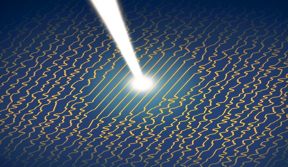Home > Press > A new step in the search for room-temperature superconductors
 |
Abstract:
Scientists have found a new, nanoscale link between superconductivity the flow of electric current without a loss of energy and a phenomenon known as charge density waves.
A new step in the search for room-temperature superconductors
New Haven, CT | Posted on May 27th, 2022
The discovery, which is described in the journal Science, is a tantalizing step in the decades-long search for room-temperature superconductors that could unleash a new generation of electronics and computers.
The vast majority of superconducting materials operate at intensely cold temperatures, typically below -320 degrees Fahrenheit, making them impractical to use without a cooling system. Developing superconductors that operate at warmer temperatures could transform everything from laptop computers to regional power grids.
Knowing what makes these materials superconductors gets us closer to being able to control them. Were looking for any connection that relates to their superconductivity, said Eduardo H. da Silva Neto, an assistant professor of physics in Yales Faculty of Arts and Sciences Yale and co-author of the new study. He is also a faculty member of Yales Energy Sciences Institute at West Campus.
The research team, which is led by the U.S. Department of Energys SLAC National Accelerator Laboratory at Stanford University and includes scientists from Yale, the University of British Columbia, and other institutions focused their study on a material called yttrium barium copper oxide (YBCO).
They found that YBCOs superconductivity was linked at the nanoscale level with charge density waves ripples in the density of electrons in the material.
When the scientists reduced YBCOs superconductivity, by exposing it to infrared light, the materials charge density waves increased and organized themselves in a more even, synchronized pattern. Conversely, when superconductivity was increased, the materials charge density waves became less organized.
In other words, superconductivity and charge density waves co-exist but they dont like each other, da Silva Neto said. Weve essentially found a tuning knob to alter the shape of charge density waves, through increased or decreased superconductivity.
The next step for scientists, da Silva Neto explained, is to reverse the process and find ways to alter superconductivity via charge density waves.
A key element of the research, he added, was having access to the SLAC National Accelerator Laboratory, an underground facility in Menlo Park, California, devoted to a broad program in atomic and solid-state physics, chemistry, biology, and medicine.
Giacomo Coslovich, a staff scientist at the SLAC laboratory, was corresponding author of the new study; Scott Wandel of SLAC was the studys first author. Tim Boyle, a visiting assistant in research at Yale, was a co-author of the study.
The research was funded, in part, by the U.S. Department of Energy Office of Science, the Alfred P. Sloan Fellowship in Physics, and the National Science Foundation.
####
For more information, please click here
Contacts:
Fred Mamoun
Yale University
Office: 323-363-1093
Copyright © Yale University
If you have a comment, please Contact us.
Issuers of news releases, not 7th Wave, Inc. or Nanotechnology Now, are solely responsible for the accuracy of the content.
News and information
![]()
A sunlight-driven self-healing anti-corrosion coating May 27th, 2022
![]()
New route to build materials out of tiny particles May 27th, 2022
![]()
Nanoscale chemically ordered-disordered domains in Fe3Pt alloys and their three-dimensional interface and lattice strain May 27th, 2022
![]()
Observation of fractional exclusion statistics in quantum critical matter May 27th, 2022
Superconductivity
![]()
Quantum shock absorbers allow perovskite to exhibit superfluorescence at room temperature April 1st, 2022
![]()
Better understanding superconductors with Higgs spectroscopy Prof. Stefan Kaiser from TU Dresden awarded ERC Consolidator Grant March 18th, 2022
Govt.-Legislation/Regulation/Funding/Policy
![]()
A one-stop shop for quantum sensing materials May 27th, 2022
![]()
Diabetes drug improves antibacterial treatment speed and effectiveness, researchers report May 27th, 2022
![]()
On-Chip Photodetection: Two-dimensional material heterojunctions hetero-integration May 13th, 2022
Possible Futures
![]()
A sunlight-driven self-healing anti-corrosion coating May 27th, 2022
![]()
New route to build materials out of tiny particles May 27th, 2022
![]()
Nanoscale chemically ordered-disordered domains in Fe3Pt alloys and their three-dimensional interface and lattice strain May 27th, 2022
![]()
Observation of fractional exclusion statistics in quantum critical matter May 27th, 2022
Discoveries
![]()
How randomly moving electrons can improve cyber security May 27th, 2022
![]()
A one-stop shop for quantum sensing materials May 27th, 2022
![]()
Diabetes drug improves antibacterial treatment speed and effectiveness, researchers report May 27th, 2022
Announcements
![]()
How randomly moving electrons can improve cyber security May 27th, 2022
![]()
A one-stop shop for quantum sensing materials May 27th, 2022
![]()
Diabetes drug improves antibacterial treatment speed and effectiveness, researchers report May 27th, 2022
Interviews/Book Reviews/Essays/Reports/Podcasts/Journals/White papers/Posters
![]()
How randomly moving electrons can improve cyber security May 27th, 2022
![]()
A one-stop shop for quantum sensing materials May 27th, 2022
![]()
Diabetes drug improves antibacterial treatment speed and effectiveness, researchers report May 27th, 2022
Grants/Sponsored Research/Awards/Scholarships/Gifts/Contests/Honors/Records
![]()
On-Chip Photodetection: Two-dimensional material heterojunctions hetero-integration May 13th, 2022
![]()
Small microring array enables large complex-valued matrix multiplication May 13th, 2022
![]()
The future of desalination? A fast, efficient, selective membrane for purifying saltwater May 13th, 2022










